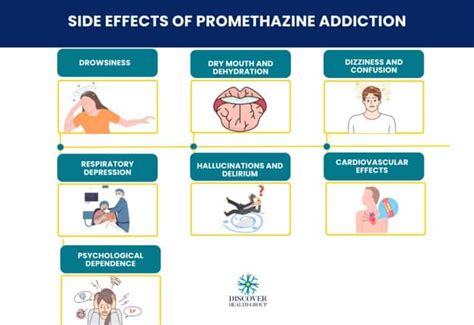Intro
Discover key facts about Promethazine, a potent antihistamine, including its uses, side effects, and interactions, to understand its role in treating allergies, nausea, and anxiety, while exploring its pharmacology and medical applications.
Promethazine is a medication that has been widely used for various purposes, including as an antihistamine, an antiemetic, and a sedative. Despite its widespread use, there are many aspects of promethazine that are not well understood by the general public. In this article, we will delve into the world of promethazine and explore five key facts about this medication.
The importance of understanding promethazine cannot be overstated. With its numerous applications and potential side effects, it is crucial for individuals to be well-informed about this medication. Whether you are a healthcare professional or simply someone who has been prescribed promethazine, having a thorough understanding of its benefits and risks is essential. By reading on, you will gain a deeper understanding of promethazine and be better equipped to make informed decisions about its use.
Promethazine has a long history of use, dating back to the 1940s. Initially developed as an antihistamine, it quickly gained popularity due to its effectiveness in treating a range of conditions, from allergies to motion sickness. Over the years, its applications have expanded, and it is now used for a variety of purposes, including as a sedative and an antiemetic. Despite its widespread use, promethazine remains a topic of interest and debate, with many individuals seeking to learn more about its benefits and risks.
What is Promethazine?

History of Promethazine
Promethazine was first synthesized in the 1940s by a team of scientists at the French pharmaceutical company, Rhône-Poulenc. Initially marketed as an antihistamine, it quickly gained popularity due to its effectiveness in treating a range of conditions. Over the years, its applications have expanded, and it is now used for a variety of purposes, including as a sedative and an antiemetic. Today, promethazine is available in a range of formulations, including tablets, suppositories, and injectable solutions.Benefits of Promethazine

Uses of Promethazine
Promethazine has a range of uses, including: * Treating allergic reactions such as hives, itching, and sneezing * Preventing motion sickness and nausea * Treating insomnia and anxiety * Preventing vomiting and nausea * Treating symptoms of the common cold, such as runny nose and sneezingRisks and Side Effects of Promethazine

Interactions with Other Medications
Promethazine can interact with a range of other medications, including: * Antihistamines and decongestants * Sedatives and tranquilizers * Opioid pain medications * Antidepressants and anti-anxiety medications * Muscle relaxants and sleep aidsPrecautions and Warnings

Dosage and Administration
The dosage and administration of promethazine will depend on the individual's specific needs and the condition being treated. Generally, promethazine is taken orally, with doses ranging from 12.5mg to 50mg per day. It is essential to follow the recommended dosage and administration instructions to minimize the risk of side effects and interactions.Conclusion and Final Thoughts

We invite you to share your thoughts and experiences with promethazine in the comments below. Have you taken promethazine for a specific condition? What were your experiences with the medication? Share your story and help others make informed decisions about their health.
What is promethazine used for?
+Promethazine is used to treat a range of conditions, including allergic reactions, motion sickness, insomnia, and nausea.
What are the side effects of promethazine?
+Promethazine can cause a range of side effects, including drowsiness, dry mouth, blurred vision, constipation, and urinary retention.
Can I take promethazine with other medications?
+Promethazine can interact with a range of other medications, including antihistamines, sedatives, and opioid pain medications. It is essential to consult with your doctor before taking promethazine with other medications.
How should I take promethazine?
+Promethazine is typically taken orally, with doses ranging from 12.5mg to 50mg per day. It is essential to follow the recommended dosage and administration instructions to minimize the risk of side effects and interactions.
What are the precautions and warnings associated with promethazine?
+Promethazine can cause respiratory depression and arrest, seizures, and convulsions. It is essential to monitor for signs of these conditions and seek medical attention immediately if they occur.
